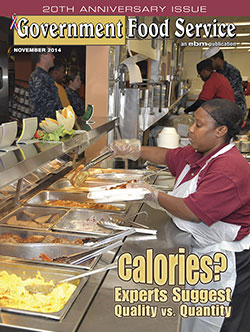

EDITORIAL COMMENT: The Serving Line
November 2014
Military Food Service:
Committed to Success
In looking back over the 20 years since the premiere issue of Government Food Service in November 1994, it seems that the mission of supplying the military with steady, reliable access to high-quality, nutritious food is constantly challenged.
Still, military food service maintains a special effort to perform optimally and a dedication to contribute to quality of life in this dynamic and demanding environment.
Steady changes made to supplies acquisition since the end of World War II consistently attempt to rein in costs associated with purchase, storage and distribution.
The single-manager system that consolidated much of Defense Department procurement after the Korean War was replaced in 1962 by what is now the Defense Logistics Agency (DLA). At the time, specific categories of supplies had been assigned to a single service for inventory management, with food and clothing handled by the Army.
A further attempt to achieve efficiencies, reduce inventory and cut overhead costs came in 1993, when the Subsistence Prime Vendor program began to replace the depot stock approach to distribution.
Federal belt-tightening after 2008 triggered the latest cost-cutting campaign. First, streamlining of the prime vendor program catalog in 2009 reduced the number of line items by 34.5 percent overall. Then, DLA followed in 2013 with the Enterprise Cost Reduction program, which seeks a 10 percent reduction in costs by fiscal 2018. Contributing to that goal, purchasing outside the continental United States (OCONUS) is being consolidated by selecting one or more suppliers in each of five specific prime vendor categories.
Troop deployments in support of military actions over the last 20 years further tested and fine-tuned military foodservice performance. The war on terror in the Middle East and Southwest Asia dominated the last decade.
In the field, the Army Center of Excellence, Subsistence (ACES), instituted a Contingency Operations (CONOPS) 21-day LIA (Line Item A) Menu, which established a menu platform and a foodservice upgrade plan.
Deployment of service members overseas diverted trained culinary specialists from food preparation to the primary responsibility of warfare. As a result, more pre-processed/advance food items were used to speed cooking time and make up for the diminished culinary expertise available for meal preparation. With withdrawal from Iraq completed by the end of 2011 and the last soldiers due to leave Afghanistan by the end of 2016, culinary expertise is returning and the pendulum is swinging back in the direction of cooking using more fresh ingredients.
If the past is any predictor of the future, military food service will face continuing challenges to overcome. The Healthy Base Initiative is due to be completed in 2015; the military responds to dietary guidelines that the U.S. Department of Agriculture revises every five years; the Air Force is progressing with its Food Transformation Initiative; and the Army is investigating its own campus-style model.
Like any proven competitor, military food service is undeterred by challenges to its mission and is committed to continuing a record of success into the future.
